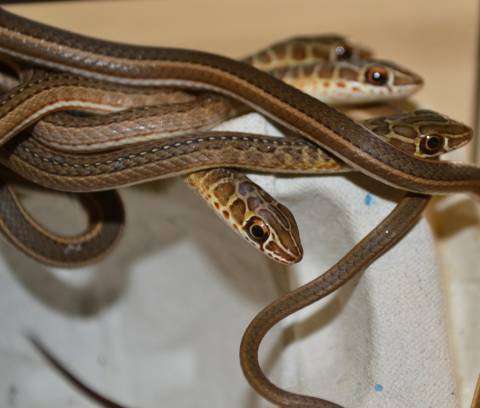
Description:
Scientific name: Psammophis sibilans
Life span: 10 years
Psammophis sibilans, a small to medium-sized Psammophiine snake, can grow to be approximately 140 cm long but typically grows to be somewhat shorter. The head is elegantly placed aside from the small neck, and the body is slim and graceful. The eyes are big and have circular pupils, and the head is somewhat elongated.

Native Region/Habitat
This species can be found all over Africa, with the exception of the northwestern and southernmost parts. However, they are absent from tropical forests and are frequently replaced by species like P. schokari in genuine desert environments.
Behavior:
In a few weeks or months, these snakes become extremely frightened and flighty and begin to eat voraciously from forceps. They dislike handling and will squirm erratically, whirl in the hand, stink, and try to bite.
Care As a pet/In captivity:
Housing: This species is fairly simple to maintain in captivity because it only needs dry, warm temperatures. They need to be kept dry at all times since they cannot handle prolonged moisture. It is vital to have a tiny water bowl, even though they hardly ever drink from it. They need warm temperatures with a significant decrease to room temperature at night.
There are two schools of thought regarding housing this species, as there are with all snakes. Although, as previously mentioned, they find it quite easy to leap out of a top-opening box and will frequently attempt to plunge out when it is opened, they can live perfectly well in a “rack” style setup. However, a larger, more naturalistic enclosure is advised to get a true sense of how engaging and energetic this species can be. This species, which is quick moving, active, and curious, will benefit greatly from a larger terrarium to roam and investigate. They will give the keeper countless hours of enjoyment this manner, as well as potentially some of the unique behaviors for which they are becoming well-known. To truly appreciate the snakes’ motions and activity, a long terrarium is advised; at least 48″ is ideal. It’s better to have a side-opening door for obvious reasons.
Feeding: These snakes are generalist feeders in the wild, consuming lizards, smaller snakes, rodents, and small birds. These snakes exhibit a lack of bother when in captivity and readily take the right size frozen and thawed rats. It’s not difficult to get them to eat; many snakes will accept prey from forceps within days of being bought, while others may initially only take food left out overnight. Nonetheless, these snakes usually calm down enough to approach the keeper and accept food from forceps. They will also accept young quail.
This species is more active than most snakes, has a high metabolism, and needs to eat more frequently. The snakes tend to manage smaller prey things better than huge prey items, hence the author recommends multiple little feeds at regular intervals, typically every 5-7 days. With this routine, the snakes will eat voraciously and almost never miss a meal.
Table





